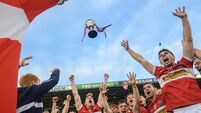Disney loses some magic on cable TV and dollar hit

Disney, which had been the top-performing stock in the Dow Jones Industrial Average this year, said operating income will be reduced by $500m (€456.6m) next year as a result of the strong dollar. The stock slid 8.4% at one stage in New York.
The company is facing two challenges: fewer subscribers at cable networks such as ESPN, its biggest business, and foreign exchange losses from the strong dollar that are cutting results for both cable TV and international theme parks. The warning unsettled investors accustomed to stellar sales and profit from the Burbank, California-based company.
















